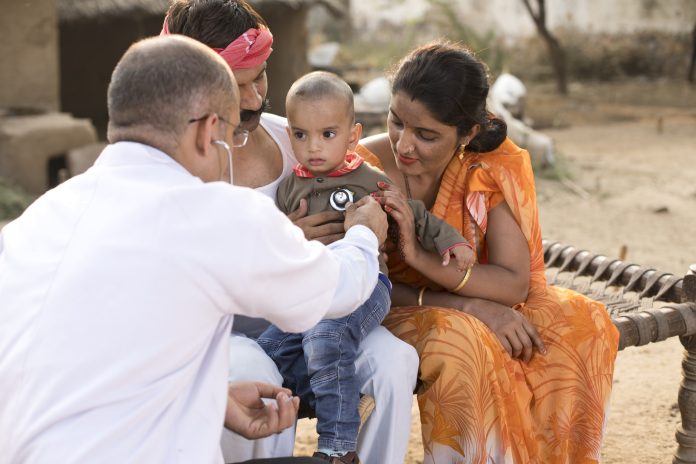The World Health Organization (WHO) is actively working to improve access to healthcare for under-served communities, targeting low-income, rural, and marginalized populations. Zisis Kozlakidis and Debra Leiolani Garcia provide an overview of these initiatives
The concept of health equity is at the core of many national and international organizations, including the United Nations, and has been defined by the World Health Organization (WHO) as ‘achieved when everyone can attain their full potential for health and wellbeing’. However, many communities globally remain under- served, i.e., with limited access to essential resources, services, and opportunities. These communities often face a mix of structural, geographic, social, and/or economic barriers that prevent them from receiving the necessary level of support. In healthcare, often the example given would be a lack of sufficient healthcare facilities, medical professionals and essential services, such as maternal and child care as well as emergency care. (1) In some instances, these services may exist and be available, but at a cost that is unaffordable, in which case the financial barriers would contribute to poor access. The latter is, for example, true in remote geographical regions of low-income countries, where entire communities would be living in poverty and would have to travel long distances to receive any care. However, under-served communities can exist within highly urban environments; for example, communities facing housing insecurity may struggle to access essential health services. Addressing the challenges of under-served communities, the World Health Organization (WHO) is actively working to improve access to healthcare by implementing several key strategies. These efforts target low-income, rural, and marginalized populations. The current article provides a high-level view of these initiatives.
Focusing on infrastructures and healthcare systems
One of WHO’s primary goals is to advance Universal Health Coverage (UHC), ensuring that everyone can have access to essential health services without financial hardship. For example, the partnership UHC 2030 provides a platform where multiple stakeholders can connect, work together and influence national and international commitments. Additionally, the UHC Partnership is part of WHO’s Special Programme on Primary Health Care, which promotes a whole-of-society approach in addressing health priorities and empowering people to take part in making decisions that affect their health and wellbeing. These initiatives focus on two main areas of advancement: i) the strengthening of healthcare systems, supporting governments in improving infrastructure, financing, and governance in health systems, especially in under-served areas, and ii) the equitable service delivery, i.e. addressing and/or removing the barriers mentioned previously, such as costs, geographic challenges, and social exclusion.
An important part of healthcare strengthening is the reinforcement of primary health systems, as these are often the first points of contact for under-served communities, and enhancing the availability and training of healthcare workers is impactful. At the same time, digital health technologies are seen as one of the solutions to bridge gaps in healthcare access, for example, mobile health applications and telemedicine programs that can reach remote or rural areas that have otherwise limited access to physical healthcare facilities. Lastly, as a complementary action, the WHO works to ensure access to ‘essential medicines and vaccines’ in under-served communities by developing sustainable supply chains for necessary drugs.
Focusing on the people delivering healthcare for under-served communities
The focus on infrastructure and healthcare systems goes hand in hand with the focus on the people tasked to deliver the healthcare. As such, workforce development is a critical aspect and can include several facets, from training local healthcare workers, including community health workers and midwives, to encouraging policies that ensure healthcare workers are distributed more evenly and thus reduce service gaps. At the same time, research and informational campaigns can be undertaken to encourage policymakers to address the social determinants of health – such as education and living conditions- that affect under-served communities disproportionally. It has to be noted that access to healthcare should be viewed holistically and – in an ideal scenario – should include behavioural health clinicians integrated as part of the healthcare services offering. (2) Finally, increasing the availability of healthcare in under-served communities would mean that such communities will be more resilient and better equipped to prepare for and respond to health emergencies, such as epidemics and natural disasters. The recent COVID-19 pandemic has been a characteristic example where the impact has been disproportionate for under-served communities. (3)
The urgency to address healthcare for under-served communities remains unabated post-pandemic. On the one hand, further research is required to collect data to better understand the specific healthcare needs of under-served populations and, subsequently, use this data to inform and direct policy recommendations.
On the other hand, this process would include the development and implementation of frameworks for tracking progress toward equitable access to healthcare, helping governments tailor their approaches to population groups and monitoring the impact of public health interventions. To attain this goal of true global healthcare accessibility, multisectoral partnerships and collaborations with and within governmental organizations, non-governmental organizations (NGOs), and international agencies must work together to develop and sustain policies and frameworks for under-served communities.
Disclaimer
Where authors are identified as personnel of the International Agency for Research on Cancer/WHO, the authors alone are responsible for the views expressed in this article. They do not necessarily represent the decisions, policies or views of the International Agency for Research on Cancer/WHO.
References
1. Booty, Edward. ‘Delivering healthcare to the underserved.’ (2023): 70.
2. O’Loughlin, Kristen, et al. ‘Using integrated behavioral healthcare to address behavioral health disparities in underserved populations.’ Translational Issues in Psychological Science 5.4 (2019): 374.
3. Tai, D. B. G., Shah, A., Doubeni, C. A., Sia, I. G., & Wieland, M. L. (2021). The disproportionate impact of COVID-19 on racial and ethnic minorities in the United States. Clinical infectious diseases, 72(4), 703-706.











